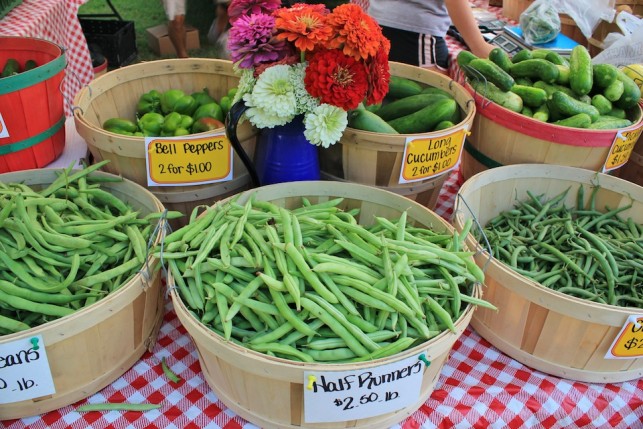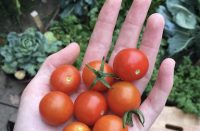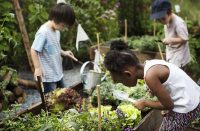This spring, in a personal challenge to eat local and reduce my carbon footprint, I planted my first vegetable garden. I spent $50 on seeds and planted all my favourite vegetables, including tomatoes, peppers, peas, radishes, carrots, beets, onions and spinach. I was quite excited, but since growing these vegetables would take most of the summer, I decided to investigate local food options in Fredericton. My discoveries ended up reinforcing my decision grow my own food – while my city provides plenty of options, few are sourced locally.
This spring, in a personal challenge to eat local and reduce my carbon footprint, I planted my first vegetable garden. I spent $50 on seeds and planted all my favourite vegetables, including tomatoes, peppers, peas, radishes, carrots, beets, onions and spinach. I was quite excited, but since growing these vegetables would take most of the summer, I decided to investigate local food options in Fredericton. My discoveries ended up reinforcing my decision grow my own food – while my city provides plenty of options, few are sourced locally.
The local farmers’ market was my first priority, but due to limited transportation options I had trouble getting there on Saturday mornings. My next stop was a meat market – what we call small grocers in Fredericton. Since most are locally owned and operated, I assumed they also supported the local economy. While they did supply a variety of vegetables from Canada and the US, they also had the same fruit selection as major grocery stores (papayas, mangoes, etc.). They also advertised USDA-approved beef. What happened to supplying Canadian beef? Given the small size of the store, I was sure they could find enough local beef to stock their shelves.
I visited a second local market that had roughly the same produce selection, minus the exotic fruit. When I asked where their meat came from, “mostly Alberta” was their response. However, their fresh rhubarb and local raspberries made them better supporters of food producers in the Fredericton area than the last store.
My next stop was Sobey’s. While it is a major grocery chain, Sobey’s has a sustainability platform that encourages greenhouse gas (GHG) reductions, such as buying local so that food doesn’t have to travel long distances. Nonetheless, their “Product of USA” raspberries were prominently displayed in the middle of the local raspberry season. As I continued to peruse the store, the only “Choose Atlantic” products I could find were green peppers, apples, Atlantic Salmon and prepackaged deli meats. What about the tomatoes, carrots and cucumbers?
With low expectations in tow, my last stop was Superstore. I was surprised by the amount of Canadian produce available. Unfortunately, while Canadian produce such as radishes, carrots, strawberries and apples were on display, beside them were the same varieties from the US and New Zealand.
Overall, I was quite surprised with the stores in my area. To address demands, grocers are more concerned with making sure their customers have every possible option under one roof, instead of considering local options much closer to their stores. Is it really necessary to ship produce from afar when it is available right here in our backyards?
After making these discoveries, I looked harder for local produce options. I found a store that supplies only local produce, meat and fish. A new farmers’ market also opened later on in the summer in a more convenient location with flexible hours. Needless to say, I’ll think twice about going to any grocery store in the future, and will do what I can to support the local economy and keep my foodprint to a minimum!
Good gardening
Now that the summer is long over and my garden has been cleaned out, here are a few lessons I learned along the way:
- Pick spinach early and often. The leaves may not be that big, but it is likely ready.
- Don’t plant carrots, beets, radishes and other root vegetables really close together. Ample spacing of at least two inches allows them to grow big (instead of long and skinny).
- Plant tomatoes early to ensure they get lots of sunlight when they’re ripening. At the same time, don’t underestimate green tomatoes – you can make lots of goodies with them!
- Be aware of the positions of the plants so each plant gets adequate sunlight – most plants require at least 6 hours of direct sunlight per day.
- Live Green Toronto has a great guide for growing your own food. If you rent and don’t have access to a garden, The Halifax Garden Network has a great guide for container gardening.
Extra credit
According to the David Suzuki Foundation’s Nature Challenge, eating locally is one of the top 10 things you can do to reduce your environmental footprint.
- You can find local food in your area by visiting LocalEating.ca
- Check out this list of Eat Local initiatives in BC (and across Canada) at GetLocalBC.org
- Learn more about sustainable procurement at LocalFoodPlus.ca
Julia is pursuing her MSc in Environment & Management at Royal Roads University, and currently lives in Fredericton, NB.
The Green Student blog shows off a sampling of writing from TheGreenStudent.ca, Alternatives’ sister site aimed at students in environment-related programs. In addition to housing Alternatives’ comprehensive guide to environmental education in Canada, TGS provides students with a forum for sharing their writing, campaigns, and events.
Julia is pursuing her MSc in Environment & Management at Royal Roads University, and currently lives in Fredericton, NB.













